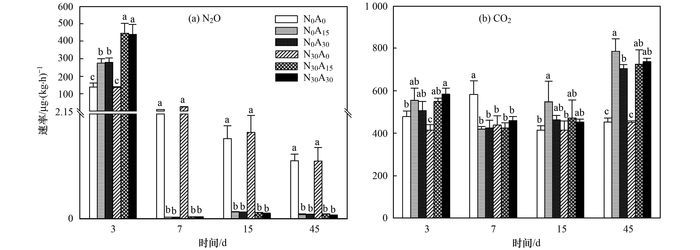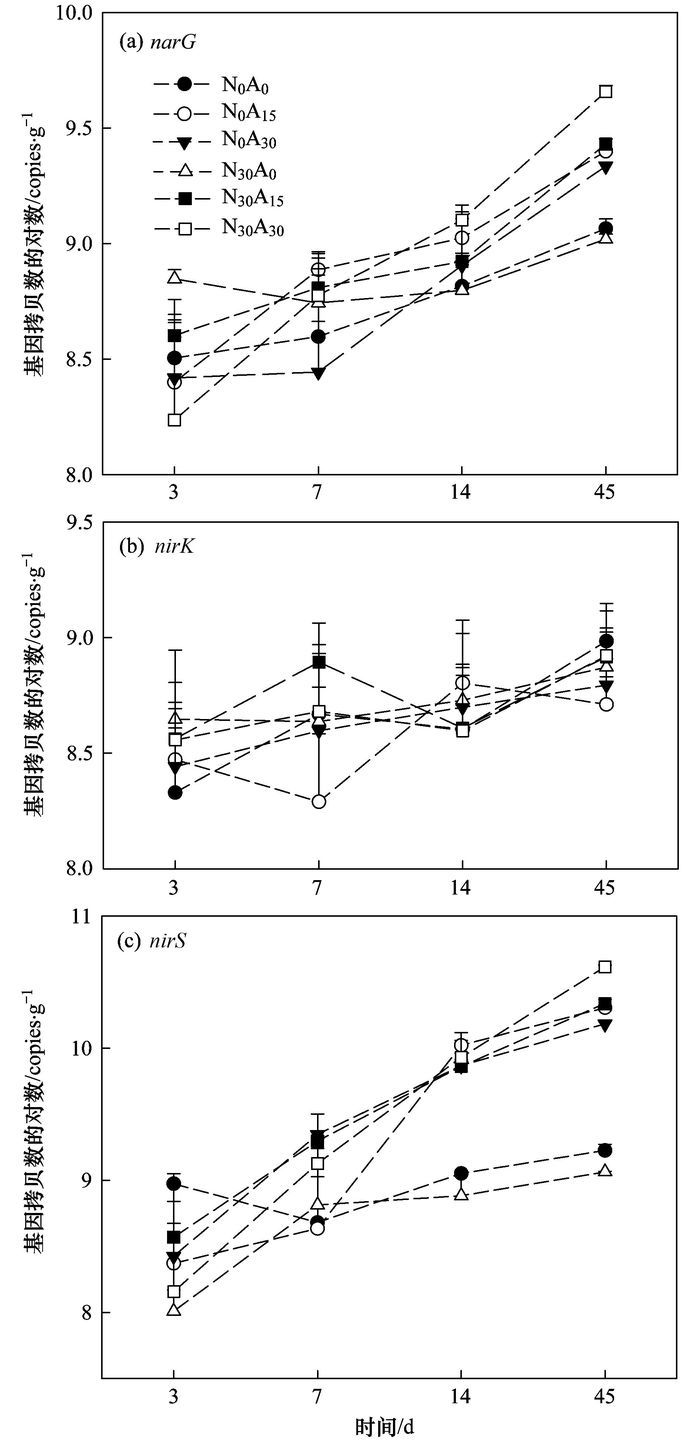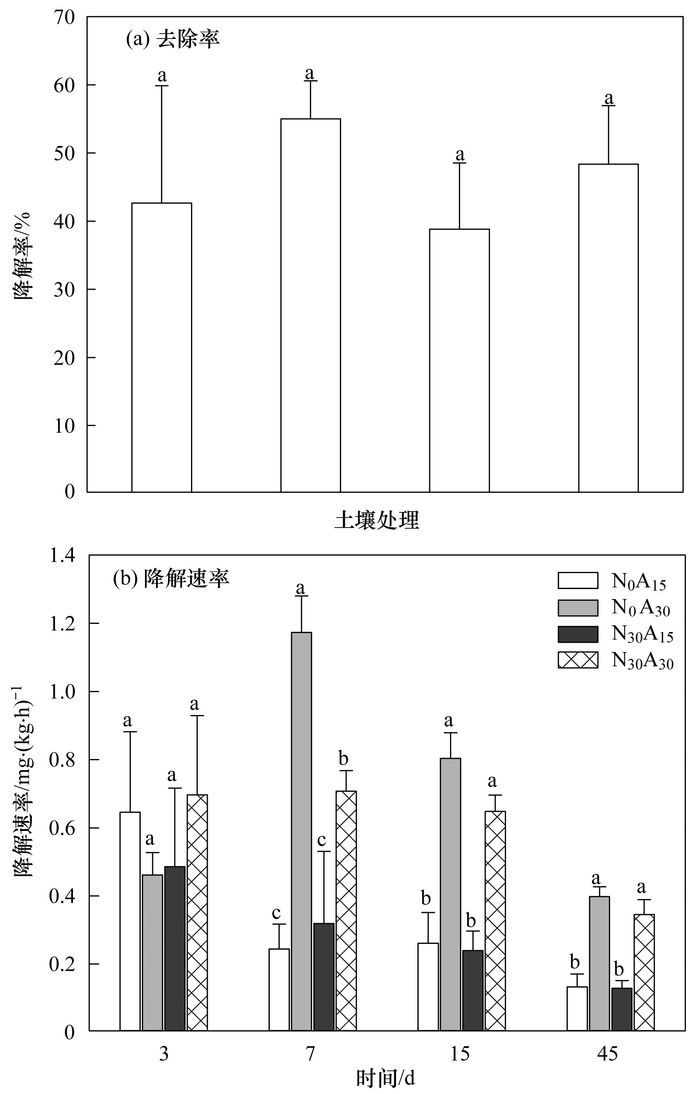多环芳烃(polycyclic aromatic hydrocarbons, PAHs)是一类广泛分布于环境中由两个或两个以上的苯环组成的有机化合物, 具有强烈的三致作用, 且可在环境中长期滞留, 因此美国环境保护署和欧盟均已将其列为重点监控的典型有机污染物[1~3].土壤是PAHs最大的汇, 源于焚化燃烧, 汽车尾气, 工业等人为活动的PAHs均可通过直接或间接的途径进入土壤, 进而威胁土壤生态系统并危害人类健康[4, 5].因此, 土壤PAHs的污染及修复一直是环境科学研究的热点.土壤中的PAHs在好氧及厌氧条件下均能被微生物降解.其中, 好氧PAHs的降解具有高效, 迅速的特点, 且多数PAHs的好氧降解机制也已被阐明[6~8].然而, 土壤环境的复杂性决定了其中必然存在大量的微氧及厌氧微环境, 因而厌氧代谢在去除土壤中PAHs的作用也不可忽视[9].尽管, 多数PAHs厌氧降解的机制还不清楚, 但其在反硝化、硫酸盐还原、铁还原及产甲烷体系下的厌氧降解已经被证实[10].其中, 以硝酸盐为电子受体的反硝化过程在土壤中广泛存在[11], 该过程是反硝化微生物在微氧或厌氧条件下, 由一系列酶促反应将硝酸盐逐级还原, 最终形成一氧化氮(NO)、氧化亚氮(N2O)或分子氮(N2)的生物化学过程, 编码这些酶促反应关键酶的功能基因也常被用作研究环境中反硝化微生物群落组成的分子标识物[12, 13].当前, 从清洁及PAHs污染的土壤或沉积物中均获取到能够有效降解典型PAHs(萘、菲、芘)的反硝化菌株或富集菌群[14~18], 且有研究表明厌氧条件下土壤中菲、蒽、芘及芴降解的同时均伴随着反硝化过程[19].可见, 清洁和污染土壤中均存在具备反硝化降解PAHs能力的微生物, 其在反硝化条件下具有降解PAHs的潜力.然而, 土壤反硝化过程对PAHs的响应机制及其在PAHs去除中的作用还不清楚.
蒽(Anthracene)是一种典型的含3个苯环的稠环PAHs, 水溶性低, 性质稳定, 具有急性毒性及致癌性, 是美国环保总署所列的16种优先控制PAHs之一, 也常被用作研究PAHs污染毒性及降解的模式化合物[20].鉴于此, 本研究通过添加硝酸盐(反硝化过程的电子受体)和蒽的厌氧土壤微宇宙培养实验, 测定培养过程中反硝化酶活性、反硝化相关功能基因(narG: periplasmic nitrate reductase gene; nirK: copper-containing nitrite reductase gene; nirS: cd1-nitrite reductase gene)丰度及土壤蒽含量的变化, 探讨厌氧条件下硝酸盐对反硝化微生物活性、丰度及土壤蒽降解的影响, 以期为进一步深入研究土壤反硝化过程与PAHs去除的偶联机制打下基础.
1 材料与方法 1.1 土壤的采集及微宇宙培养用于培养的土壤样品采集于地处江汉平原腹地的湖北省汉川市的稻麦轮作农田(113°30′3″E, 30°42′37″N)表层土(0~20 cm).去除鲜土中的碎石和植物残体后, 过2 mm筛, 备用.主要理化性质如下:pH 7.58、有机质21.86 mg·kg-1、有效磷15.94 mg·kg-1、硝酸根51.33 mg·kg-1、PAHs未检出.
厌氧微宇宙培养实验中设置了不含硝酸盐(N0)和含30 mg·kg-1硝酸盐(N30)的两组处理, 每组处理分别设置3个含不同蒽浓度的处理(0、15、30 mg·kg-1, 分别表示为A0、A15、A30), 共6个处理(N0A0、N0A15、N0A30、N30A0、N30A15、N30A30), 每个处理3次重复.实验过程简述如下:取上述备用的鲜土于25℃避光活化一周, 然后将其等分成添加和不添加硝酸盐两组, 前者均匀喷洒硝酸钠溶液(1 000 mg·L-1), 后者喷洒相同体积的去离子灭菌水, 过2 mm筛; 随后, 将上述两组处理土壤分别进行三等分, 根据设置的蒽浓度, 喷洒等体积不同蒽浓度的丙酮溶液(以500 mg·L-1的蒽丙酮溶液为母液)并充分混匀, 最终在两组处理中分别得到不同蒽含量(0、15、30 mg·kg-1)的3个处理; 将6个处理的土壤置于通风橱中1 h, 待丙酮充分挥发后, 分别分装至100 mL血清瓶(每瓶30 g, 以土计), 并用丁基胶塞和铝盖封口; 向血清瓶中通入高纯氮气吹洗5 min后, 用装水注射器调节平衡, 最后置于25℃避光恒温培养.培养过程中, 每7 d或取样前的24 h用高纯氮气冲洗换气一次, 分别于培养的第3、7、15及45 d测定血清瓶上方N2O和CO2的浓度, 同时取样(非破坏性取样)测定各处理土壤中蒽的含量, 并提取DNA进行后续的定量PCR测定.
1.2 N2O和CO2的测定在培养的第3、7、15及45 d(24 h前进行换气处理), 用注射器抽取血清瓶上方的气体, 用气相色谱(Agilent Technologies 7890A, USA)测定各处理24 h内产生的N2O和CO2的浓度, 并计算N2O和CO2的产生速率.
1.3 土壤DNA提取及定量PCR使用Fast DNA® SPIN Kit for Soil(MP Biomedicals, USA)试剂盒并参照其说明书来提取各土壤样品中的DNA.获取的DNA, 经1%的琼脂糖凝胶电泳检测后, -20℃保存备用.
本研究中, 参照He等[21]的方法制备narG、nirK和nirS基因的质粒及标准曲线, 在荧光定量PCR仪(ABI 7500, Applied Biosystems, USA)上用SYBR GREEN法进行. 25 μL的反应体系组成为:2×SYBR Premix Ex TaqⅡ(TaKaRa, Japan)12.5 μL, 上下游引物各1 μL, ROX-Reference DyeⅡ(TaKaRa, Japan)0.5 μL, DNA模板1 μL, 无菌水补足25 μL.各基因扩增所用的引物序列及反应条件见表 1.扩增反应完成后, 设置了溶解曲线程序(60~95℃), 用来检测定量PCR产物的特异性, 最后通过ABI 7500 Software(version 2.0.6)来分析所得的数据并计算各样品中基因的拷贝数.
|
|
表 1 定量PCR中所使用的引物及扩增程序 Table 1 Primer sets and amplification programs used in the quantitative PCR |
1.4 土壤蒽含量的测定及相关计算
土壤蒽的提取参照姚等[25]的方法, 采用经典的索氏提取法进行提取和浓缩[26].随后以蒽的标准品(Dr. Ehrenstorfer, Germany)配制标准曲线, 用高压液相色谱仪(HITACHI L-7100, Japan)测定各样品中蒽含量.检测条件为:Allsphere C18柱(250 mm×4.6 mm), 进样量10 μL, 流速0.6 mL·min-1, 温度30℃, 以甲醇(A相)和去离子水(B相)为流动相进行梯度洗脱, 检测波长274 nm.蒽的最终去除率及降解速率分别通过公式(1)和(2)来计算:

|
(1) |

|
(2) |
式中, A0为第0 d土壤蒽含量(mg·kg-1), A45为培养45 d后土壤蒽含量(mg·kg-1), Ai为第i d土壤蒽含量(mg·kg-1), i为培养时间(d).
1.5 数据处理实验数据的统计分析在SPSS 19.0软件中进行, 各处理差异显著性检测采用单因素方差分析(S-N-K检验, P<0.05表示差异显著).用Two-way repeated ANOVA检验硝酸盐, 蒽及其交互作用对土壤气体(N2O、CO2)产生速率、反硝化功能基因(narG、nirK、nirS)丰度及蒽降解速率影响的显著性.上述指标间的相关性用直线相关分析(Bivariate过程), 采用Spearman相关系数计算, 双尾显著性检验.
2 结果与分析 2.1 培养期间土壤N2O和CO2的产生速率图 1为厌氧培养期间各处理土壤N2O及CO2的产生速率.由图 1(a)可知, 各处理土壤在培养初期(3 d)具有较高的N2O产生速率[135.6~445.3 μg·(kg·h)-1, 以土计], 同时添加硝酸盐和蒽(N30A15、N30A30)的处理显著高于只添加蒽(N0A15、N0A30)的处理(P<0.05), 且它们均显著高于不含蒽(N0A0、N30A0)处理(P<0.05).在其它各取样时间各处理土壤中均只检测到较低的N2O产生速率[0.074~24.96 μg·(kg·h)-1, 以土计], 但不添加蒽(N0A0、N30A0)的处理均显著高于含蒽(N0A15、N0A30、N30A15、N30A30)的各处理(P<0.05).相关分析表明蒽含量与土壤N2O产生速率呈显著负相关(r=-0.343, P<0.05), 且硝酸盐(F=2.38, P<0.01), 蒽(F=5.29, P<0.01)及其交互作用(F=8.52, P<0.01)均能显著影响土壤N2O产生速率(表 2).从图 1(b)可知, 与N2O产生速率不同, 培养期间各处理中均能持续检测到较高的CO2产生速率[415.26~785.03 μg·(kg·h)-1, 以土计], 其中前3次取样天各处理中CO2产生速率的变化无明显规律(多数处理间差异不显著), 但在第45 d各含蒽(N0A15、N0A30、N30A15、N30A30)处理中均显著高于不添加蒽(N0A0、N30A0)各处理(P<0.05).方差分析表明蒽含量与土壤CO2产生速率呈显著正相关(r=0.658, P<0.01), 且蒽(F=34.61, P<0.01)及其与硝酸盐的交互作用(F=5.73, P<0.05)能够显著影响土壤CO2的产生速率(表 2).

|
图中的误差棒代表标准偏差(n=3), 不同小写字母表示同一取样天的不同处理间的显著性差异(P<0.05) 图 1 不同处理培养期间N2O和CO2的产生速率 Fig. 1 Production rates of N2O and CO2 for different treatments during the incubation period |
|
|
表 2 双因素重复测量方差分析检验硝酸盐(N)、蒽(A)及其交互作用(N×A)对气体(N2O、CO2)产生速率及蒽降解速率的影响1) Table 2 Two-way repeated measures ANOVA examining the effects of nitrate (N), anthracene (A), and their interaction (N×A) on the degradation rate of anthracene and gases (N2O and CO2) production rates |
2.2 培养期间土壤narG、nirK和nirS基因丰度的动态变化
各处理土壤narG、nirK及nirS基因在厌氧培养期间的丰度变化如图 2所示.由图 2(a)可知, 培养期间narG基因的丰度呈逐渐升高的趋势(2.1×108~4.6×109 copies·g-1, 以干土计), 第3 d时只添加硝酸盐(N30A0)处理中的丰度显著高于其它处理(P<0.05), 而到培养后期(45 d)各含蒽处理中的丰度均显著高于不含蒽处理(P<0.05).培养期间nirK基因丰度变化的趋势不明显[图 2(b)], 第3 d时N0A0及N0A15中的丰度显著低于其它各处理(P<0.05), 第7 d时N0A15中的丰度显著低于其它各处理(P<0.05), 但在第15及45 d各处理中该基因的丰度均无显著差异.培养期间nirS基因的丰度变化趋势与narG相似, 且在培养的第15及45 d各含蒽(N0A15、N0A30、N30A15、N30A30)处理中的丰度均显著高于不添加蒽(N0A0、N30A0)的处理(P<0.05)[图 2(c)].此外, 双因素重复检测方差分析的结果表明,硝酸盐、蒽及它们交互作用均能显著影响土壤中narG和nirS基因的丰度, 而对nirK基因丰度无显著影响(表 3).由2.1节可知, 各处理第3 d均检测到最高的N2O产生速率, 然而相关分析的结果表明,此时N2O产生速率与narG(r=-0.404, P>0.05)、nirK(r=-0.053, P>0.05)及nirS(r=-0.220, P>0.05)基因丰度之间均无显著相关.

|
图中的误差棒代表标准偏差(n=3) 图 2 不同处理培养期间narG、nirK及nirS丰度的动态变化 Fig. 2 Dynamic changes in the abundance of narG, nirK, and nirS for different treatments during the incubation period |
|
|
表 3 双因素重复测量方差分析检验硝酸盐(N)、蒽(A)及其交互作用(N×A)对土壤反硝化功能基因(narG、nirK、nirS)丰度的影响 Table 3 Two-way repeated measure ANOVA examining the effects of nitrate (N), anthracene (A), and their interaction (N×A) on the abundance of denitrification related genes (narG, nirK, and nirS) during the incubation period |
2.3 微宇宙培养中土壤蒽的最终去除率及降解速率
培养45 d后, 各含蒽土壤蒽的最终去除率如图 3(a)所示.从中可见, 厌氧条件下土壤蒽的最终去除率在33.83%~55.01%之间, 且各处理中蒽的去除率无显著差异. 图 3(b)为含蒽处理在各取样天蒽的降解速率.培养初期(3 d)各含蒽处理中蒽的降解速率无显著差异, 但在随后的第7、15及45 d, 高蒽含量(N0A30、N30A30)处理中的降解速率均显著高于低蒽含量(N0A15、N30A15)处理(P<0.05).相关分析的结果也表明蒽的降解速率与土壤蒽含量呈极显著正相关(r=0.741, P<0.01).此外, 低蒽含量(N0A15、N30A15)处理之间的降解速率在各取样时间均无显著差异, 而高蒽含量处理之间也仅在第7 d有显著差异, 即N0A30处理中蒽的降解速率显著高于N30A30处理(P<0.05).可见硝酸盐对土壤蒽的降解速率无明显促进作用, 双因素重复检测方差分析的结果也表明只有蒽浓度能显著影响蒽的降解速率(F=187.87, P<0.01), 而硝酸盐及其与蒽的交互作用均对土壤蒽的降解速率无显著影响(表 2).

|
图中的误差棒代表标准偏差(n=3)不同小写字母表示处理间的显著性差异(P<0.05) 图 3 培养结束时蒽的最终去除率和培养期间的降解速率 Fig. 3 Final removal rate of anthracene at the end of the incubation period and the degradation rate of anthracene during the incubation period |
土壤中N2O及CO2产生速率可分别表征土壤反硝化酶活性及土壤呼吸速率.本研究结果表明, 培养初期(3 d)硝酸盐和蒽的添加均能提高土壤反硝化酶活性, 而随后蒽的添加却显著抑制了土壤反硝化酶活性.当前, 严格厌氧条件下PAHs对土壤反硝化活性影响的报道还不多见, 而有氧条件下相关报道的结果也不尽一致[27~29].如, Contreras-Ramos等[28]发现菲、蒽及苯并芘的添加在培养初期(2~48 h)能够提高农田土壤的反硝化酶活性, 之后反硝化活性逐渐降低.而Guo等[29]的研究结果却发现芘的添加能显著抑制土壤反硝化酶活性, 且土壤芘浓度与反硝化酶活性之间存在清晰的剂量效应关系.这些研究均能检测到连续的反硝化酶活性, 但均是从培养土壤中取样后进行单独的厌氧培养(24 h)来测定反硝化酶活性, 这与本研究中原位的检测不同.本研究中, 仅在培养的第3 d检测较高的反硝化酶活性, 且硝酸盐和蒽的添加均能提高土壤反硝化酶活性.其中, 硝酸根作为反硝化过程的电子受体理应能够促进土壤的反硝化活性, 而蒽的添加则可能通过快速杀死部分微生物细胞, 为反硝化微生物提供了更多的速效碳源, 进而促进土壤的反硝化酶活性[30].培养3 d后, 各处理土壤反硝化酶活性迅速下降, 原因可能是严格厌氧条件下, 土壤微生物代谢过程中积累了某些抑制反硝化酶活性的产物.本研究的结果表明, 培养的3、7及15 d蒽均没有明显影响土壤的呼吸速率, 而好氧条件下, PAHs的添加通常能够抑制土壤微生物的呼吸速率[31~33].如Yang等的报道[33], 典型PAHs(萘、菲、芘)的添加能改变水稻土中的微生物群落结构并抑制微生物的代谢活性.可能是由于严格厌氧条件下微生物对污染物不敏感[34], 使得本研究中蒽的添加没有表现出对土壤CO2产生速率的影响.此外, 本研究中培养后期(45 d)蒽能促进土壤呼吸速率, 可能的原因是随着培养时间的延长, 部分蒽的中间代谢产物可能成为多数微生物能够利用的速效碳源, 从而体现出对CO2产生速率的促进效应.
本研究中, narG和nirS基因的丰度在厌氧培养期间均呈现出逐渐升高的趋势, 且硝酸盐、蒽及其交互作用在培养后期均体现出对它们的促进效应, 硝酸根既是反硝化微生物的电子受体同时也可作为微生物的氮源, 因此其对上述基因的丰度体现出明显的促进作用, 这也与前人的研究结论一致[35, 36].而培养后期, 蒽对上述基因的促进作用, 可能的原因与此时土壤呼吸速率升高的原因相同, 即土壤中含narG及nirS的微生物可能以蒽代谢过程的某些中间产物或微生物细胞的内含物为碳源快速生长.与上述基因相比, nirK基因的丰度在培养过程中的波动较小, 且硝酸盐和蒽均对其没有显著的影响.该基因与nirS基因具有相同的功能(催化亚硝酸根的还原), 但它们对污染物却常具有不同的响应[30, 37, 38].如, Hallin等[37]发现在活性淤泥中添加甲醇能够明显提升nirS基因丰度并改变其群落结构, 而对nirK基因的群落组成无明显影响, 这与本研究的结果一致.值得注意的是, 本研究中反硝化相关基因的最高丰度均未出现在培养初期(3 d), 但此时却具有最高N2O产生速率.当前, 也有不少关于土壤反硝化相关基因的丰度与反硝化活性不相关的报道[30, 39].可见, 基于DNA水平的定量PCR或许不能有效体现土壤中真正具有活性的反硝化微生物丰度.
本研究中, 经过45 d的厌氧培养, 土壤蒽的最终去除率在33.83%~55.01%之间, 该结果低于已有的关于好氧或微氧环境中蒽的去除率的报道[40~43].如, Castro-Sliva等[42]研究了蒽在盐碱土中的自然降解过程, 发现培养14 d时土壤蒽的去除率高达64%.而据Wang等报道[43], 在硝酸盐还原条件下培养80 d后, 沉积物中的蒽几乎被完全去除.可见, 氧气是影响土壤蒽去除的重要因素, 且土壤中蒽的自然衰减率作用会随培养时间的延续而升高.此外, 在培养第7、15及45 d, 高蒽含量处理中蒽的降解速率均显著高于低蒽含量处理, 已有的研究也表明PAHs的浓度通常与其降解速率呈正相关[14].有研究表明, 添加硝酸盐能有效促进土壤或沉积物中PAHs的去除[44, 45].如, Macrae等[45]发现硝酸盐的添加能够促进沉积物中低分子量多环芳烃的降解.然而, 本研究中硝酸盐的添加对蒽的降解速率没有影响, 且Yuan等[46]也发现硝酸盐的添加不能有效促进沉积物中苊、芴、蒽、菲和芘的降解.可见, 硝酸盐电子受体的添加并不一定能促进土壤PAHs的降解.可能原因有以下两点:本研究中未添加硝酸盐的处理同样检测到较强的N2O产生速率, 表明硝酸盐并不是该土壤反硝化过程的限制因子; 其次, 本研究中N2O产生速率与蒽的降解速率呈显著负相关(r =-0.343, P<0.05), 表明反硝化过程并不一定在该土壤蒽的厌氧代谢中起主要作用.
4 结论(1) 厌氧条件下, 硝酸盐与蒽的交互作用及蒽在培养初期能显著促进土壤反硝化酶活性, 而在培养7~45 d后, 蒽对土壤反硝化酶活性则有显著的抑制作用.
(2) 厌氧条件下, 硝酸盐、蒽及其交互作用均能显著影响土壤narG和nirS反硝化微生物功能基因的丰度, 主要体现在培养后期的促进效应, 但它们对nirK基因的丰度无显著作用.
(3) 厌氧条件下, 添加硝酸盐对蒽的厌氧降解没有显著影响, 蒽的厌氧降解速率与土壤初始蒽含量呈正相关.
| [1] | Clemente A R, Anazawa T A, Durrant L R. Biodegradation of polycyclic aromatic hydrocarbons by soil fungi[J]. Brazilian Journal of Microbiology, 2001, 32(4): 255-261. DOI:10.1590/S1517-83822001000400001 |
| [2] | Wild S R, Jones K C. Polynuclear aromatic hydrocarbons in the United Kingdom environment:a preliminary source inventory and budget[J]. Environmental Pollution, 1995, 88(1): 91-108. DOI:10.1016/0269-7491(95)91052-M |
| [3] | Keith L H, Telliard W A. Priority pollutants I-A perspective view[J]. Environmental Science & Technology, 1979, 13(4): 416-423. |
| [4] | Chen S C, Liao C M. Health risk assessment on human exposed to environmental polycyclic aromatic hydrocarbons pollution sources[J]. Science of the Total Environment, 2006, 366(1): 112-123. DOI:10.1016/j.scitotenv.2005.08.047 |
| [5] | Qin Y Y, Leung C K M, Lin C K, et al. Halogenated POPs and PAHs in blood plasma of Hong Kong residents[J]. Environmental Science & Technology, 2011, 45(4): 1630-1637. |
| [6] | Liang Y N, Gardner D R, Miller C D, et al. Study of biochemical pathways and enzymes involved in pyrene degradation by Mycobacterium sp. strain KMS[J]. Applied and Environmental Microbiology, 2006, 72(12): 7821-7828. DOI:10.1128/AEM.01274-06 |
| [7] | Haritash A K, Kaushik C P. Biodegradation aspects of polycyclic aromatic hydrocarbons (PAHs):a review[J]. Journal of Hazardous Materials, 2009, 169(1-3): 1-15. DOI:10.1016/j.jhazmat.2009.03.137 |
| [8] |
卫昆, 陈烁娜, 尹华, 等. 蜡状芽胞杆菌对芘的降解特性及降解酶研究[J]. 环境科学学报, 2016, 36(2): 506-512. Wei K, Chen S N, Yin H, et al. The biodegradation characteristics of pyrene Bacillus cereus and its enzyme[J]. Acta Scientiae Circumstantiae, 2016, 36(2): 506-512. |
| [9] | Zhang C L, Bennett G N. Biodegradation of xenobiotics by anaerobic bacteria[J]. Applied Microbiology and Biotechnology, 2005, 67(5): 600-618. DOI:10.1007/s00253-004-1864-3 |
| [10] | Meckenstock R U, Safinowski M, Griebler C. Anaerobic degradation of polycyclic aromatic hydrocarbons[J]. FEMS Microbiology Ecology, 2004, 49(1): 27-36. DOI:10.1016/j.femsec.2004.02.019 |
| [11] |
方芳, 陈少华. 功能基因在反硝化菌群生态学研究中的应用[J]. 生态学杂志, 2010, 29(9): 1836-1845. Fang F, Chen S H. Application of functional genes in the study of the ecology of denitrifying bacteria:a review[J]. Chinese Journal of Ecology, 2010, 29(9): 1836-1845. |
| [12] |
梁丽华, 左剑恶. 反硝化功能基因——检测反硝化菌种群结构的分子标记[J]. 微生物学通报, 2009, 36(4): 627-633. Liang L H, Zuo J E. Denitrifying functional genes-the molecular marker for detection of denitrifying community structure[J]. Microbiology, 2009, 36(4): 627-633. |
| [13] |
刘若萱, 贺纪正, 张丽梅. 稻田土壤不同水分条件下硝化/反硝化作用及其功能微生物的变化特征[J]. 环境科学, 2014, 35(11): 4275-4283. Liu R X, He J Z, Zhang L M. Response of nitrification/denitrification and their associated microbes to soil moisture change in paddy soil[J]. Environmental Science, 2014, 35(11): 4275-4283. |
| [14] | Dou J F, Liu X, Ding A Z. Anaerobic degradation of naphthalene by the mixed bacteria under nitrate reducing conditions[J]. Journal of Hazardous Materials, 2009, 165(1-3): 325-331. DOI:10.1016/j.jhazmat.2008.10.002 |
| [15] | Yang X N, Ye J X, Lyu L M, et al. Anaerobic biodegradation of pyrene by Paracoccus denitrificans under various nitrate/nitrite-reducing conditions[J]. Water, Air, & Soil Pollution, 2013, 224: 1578. |
| [16] | Lu X Y, Zhang T, Fang H H P, et al. Biodegradation of naphthalene by enriched marine denitrifying bacteria[J]. International Biodeterioration & Biodegradation, 2011, 65(1): 204-211. |
| [17] | Ambrosoli R, Petruzzelli L, Minati J L, et al. Anaerobic PAH degradation in soil by a mixed bacterial consortium under denitrifying conditions[J]. Chemosphere, 2005, 60(9): 1231-1236. DOI:10.1016/j.chemosphere.2005.02.030 |
| [18] | Rockne K J, Chee-Sanford J C, Sanford R A, et al. Anaerobic naphthalene degradation by microbial pure cultures under nitrate-reducing conditions[J]. Applied and Environmental Microbiology, 2000, 66(4): 1595-1561. DOI:10.1128/AEM.66.4.1595-1601.2000 |
| [19] | Chang B V, Shiung L C, Yuan S Y. Anaerobic biodegradation of polycyclic aromatic hydrocarbon in soil[J]. Chemosphere, 2002, 48(7): 717-724. DOI:10.1016/S0045-6535(02)00151-0 |
| [20] | Cui C Z, Zeng C, Wan X, et al. Effect of rhamnolipids on degradation of anthracene by two newly isolated strains, Sphingomonas sp. 12B[J]. Journal of Microbiology and Biotechnology, 2008, 18(1): 63-66. |
| [21] | He J Z, Shen J P, Zhang L M, et al. Quantitative analyses of the abundance and composition of ammonia-oxidizing bacteria and ammonia-oxidizing archaea of a Chinese upland red soil under long-term fertilization practices[J]. Environmental Microbiology, 2007, 9(9): 2364-2374. DOI:10.1111/emi.2007.9.issue-9 |
| [22] | Philippot L, Piutti S, Martin-Laurent F, et al. Molecular analysis of the nitrate-reducing community from unplanted and maize-planted soils[J]. Applied and Environmental Microbiology, 2002, 68(12): 6121-6128. DOI:10.1128/AEM.68.12.6121-6128.2002 |
| [23] | Braker G, Fesefeldt A, Witzel K P. Development of PCR primer systems for amplification of nitrite reductase genes (nirK and nirS) to detect denitrifying bacteria in environmental samples[J]. Applied and Environmental Microbiology, 1998, 64(10): 3769-3775. |
| [24] | Michotey V, Méjean V, Bonin P. Comparison of methods for quantification of cytochrome cd 1-denitrifying bacteria in environmental marine samples[J]. Applied and Environmental Microbiology, 2000, 66(4): 1564-1571. DOI:10.1128/AEM.66.4.1564-1571.2000 |
| [25] |
姚炎红, 王明霞, 左小虎, 等. 典型油田多环芳烃污染对土壤反硝化微生物群落结构的影响[J]. 环境科学, 2016, 37(12): 4750-4759. Yao Y H, Wang M X, Zuo X H, et al. Effects of PAHs pollution on the community structure of denitrifiers in a typical oilfield[J]. Environmental Science, 2016, 37(12): 4750-4759. |
| [26] |
曹启民, 陈桂珠, 缪绅裕. 多环芳烃的分布特征及其与有机碳和黑碳的相关性研究——以汕头国际湿地示范区三种红树林湿地表层沉积物为例[J]. 环境科学学报, 2009, 29(4): 861-868. Cao Q M, Chen G Z, Miao S Y. Distribution and correlations of polycyclic aromatic hydrocarbons with organic carbon and black carbon in surface sediments of three mangrove wetlands in the Shantou Wetland Demonstration Site, China[J]. Acta Scientiae Circumstantiae, 2009, 29(4): 861-868. |
| [27] | Alburquerque J A, Sánchez-Monedero M A, Roig A, et al. High concentrations of polycyclic aromatic hydrocarbons (naphthalene, phenanthrene and pyrene) failed to explain biochar's capacity to reduce soil nitrous oxide emissions[J]. Environmental Pollution, 2015, 196: 72-77. DOI:10.1016/j.envpol.2014.09.014 |
| [28] | Contreras-Ramos S M, Álvarez-Bernal D, Montes-Molina J A, et al. Emission of nitrous oxide from hydrocarbon contaminated soil amended with waste water sludge and earthworms[J]. Applied Soil Ecology, 2009, 41(1): 69-76. DOI:10.1016/j.apsoil.2008.09.001 |
| [29] | Guo G X, Deng H, Qiao M, et al. Effect of pyrene on denitrification activity and abundance and composition of denitrifying community in an agricultural soil[J]. Environmental Pollution, 2011, 159(7): 1886-1895. DOI:10.1016/j.envpol.2011.03.035 |
| [30] | Zhou Z F, Zheng Y M, Shen J P, et al. Responses of activities, abundances and community structures of soil denitrifiers to short-term mercury stress[J]. Journal of Environmental Sciences, 2012, 24(3): 369-375. DOI:10.1016/S1001-0742(11)60747-X |
| [31] |
郑彬, 马静静, 葛高飞, 等. B[a]P累积污染对土壤呼吸强度的影响[J]. 农业环境科学学报, 2013, 32(2): 259-266. Zheng B, Ma J J, Ge G F, et al. Influences of Benzo (a) pyrene superimposed pollution on soil respiration intensity[J]. Journal of Agro-Environment Science, 2013, 32(2): 259-266. |
| [32] | Anyanwu I N, Semple K T. Assessment of the effects of phenanthrene and its nitrogen heterocyclic analogues on microbial activity in soil[J]. SpringerPlus, 2016, 5: 279. DOI:10.1186/s40064-016-1918-x |
| [33] | Yang H, Su Y H, Zhu Y G, et al. Influences of polycyclic aromatic hydrocarbons (PAHs) on soil microbial community composition with or without vegetation[J]. Journal of Environmental Science and Health, Part A:Toxic/Hazardous Substances and Environmental Engineering, 2007, 42(1): 65-72. DOI:10.1080/10934520601015768 |
| [34] | Morgan J W, Forster C F, Evison L, et al. A Comparative study of the nature of biopolymers extracted from anaerobic and activated sludges[J]. Water Research, 1990, 24(6): 743-750. DOI:10.1016/0043-1354(90)90030-A |
| [35] | Wallenstein M D, Myrold D D, Firestone M, et al. Environmental controls on denitrifying communities and denitrification rates:insights from molecular methods[J]. Ecological Applications, 2006, 16(6): 2143-2152. DOI:10.1890/1051-0761(2006)016[2143:ECODCA]2.0.CO;2 |
| [36] | Zhou Z F, Zheng Y M, Shen J P, et al. Response of denitrification genes nirS, nirK, and nosZ to irrigation water quality in a Chinese agricultural soil[J]. Environmental Science and Pollution Research, 2011, 18(9): 1644-1652. DOI:10.1007/s11356-011-0482-8 |
| [37] | Hallin S, Throbäck I N, Dicksved J, et al. Metabolic profiles and genetic diversity of denitrifying communities in activated sludge after addition of methanol or ethanol[J]. Applied and Environmental Microbiology, 2006, 72(8): 5445-5452. DOI:10.1128/AEM.00809-06 |
| [38] | Guo G X, Deng H, Qiao M, et al. Effect of long-term wastewater irrigation on potential denitrification and denitrifying communities in soils at the watershed scale[J]. Environmental Science & Technology, 2013, 47(7): 3105-3113. |
| [39] | Boyle S A, Rich J J, Bottomley P J, et al. Reciprocal transfer effects on denitrifying community composition and activity at forest and meadow sites in the Cascade Mountains of Oregon[J]. Soil Biology and Biochemistry, 2006, 38(5): 870-878. DOI:10.1016/j.soilbio.2005.08.003 |
| [40] | Fernández-Luqueño F, Marsch R, Espinosa-Victoria D, et al. Remediation of PAHs in a saline-alkaline soil amended with wastewater sludge and the effect on dynamics of C and N[J]. Science of the Total Environment, 2008, 402(1): 18-28. DOI:10.1016/j.scitotenv.2008.04.040 |
| [41] | Zhang S Y, Wang Q F, Wan R, et al. Changes in bacterial community of anthracene bioremediation in municipal solid waste composting soil[J]. Journal of Zhejiang University Science B, 2011, 12(9): 760-768. DOI:10.1631/jzus.B1000440 |
| [42] | Castro-Silva C, Ruíz-Valdiviezo V M, Valenzuela-Encinas C, et al. The bacterial community structure in an alkaline saline soil spiked with anthracene[J]. Electronic Journal of Biotechnology, 2013, 16(5): 14. |
| [43] | Wang Y, Wan R, Zhang S Y, et al. Anthracene biodegradation under nitrate-reducing condition and associated microbial community changes[J]. Biotechnology and Bioprocess Engineering, 2012, 17(2): 371-376. DOI:10.1007/s12257-011-0567-8 |
| [44] | Shibata A, Toyota K, Miyake K, et al. Anaerobic biodegradation of 4-alkylphenols in a paddy soil microcosm supplemented with nitrate[J]. Chemosphere, 2007, 68(11): 2096-2103. DOI:10.1016/j.chemosphere.2007.02.007 |
| [45] | Macrae J D, Hall K J. Biodegradation of polycyclic aromatic hydrocarbons (PAH) in marine sediment under denitrifying conditions[J]. Water Science and Technology, 1998, 38(11): 177-185. |
| [46] | Yuan S Y, Chang B V. Anaerobic degradation of five polycyclic aromatic hydrocarbons from river sediment in Taiwan[J]. Journal of Environmental Science and Health, Part B:Pesticides, Food Contaminants, and Agricultural Wastes, 2007, 42(1): 63-69. DOI:10.1080/03601230601020860 |
 2018, Vol. 39
2018, Vol. 39


